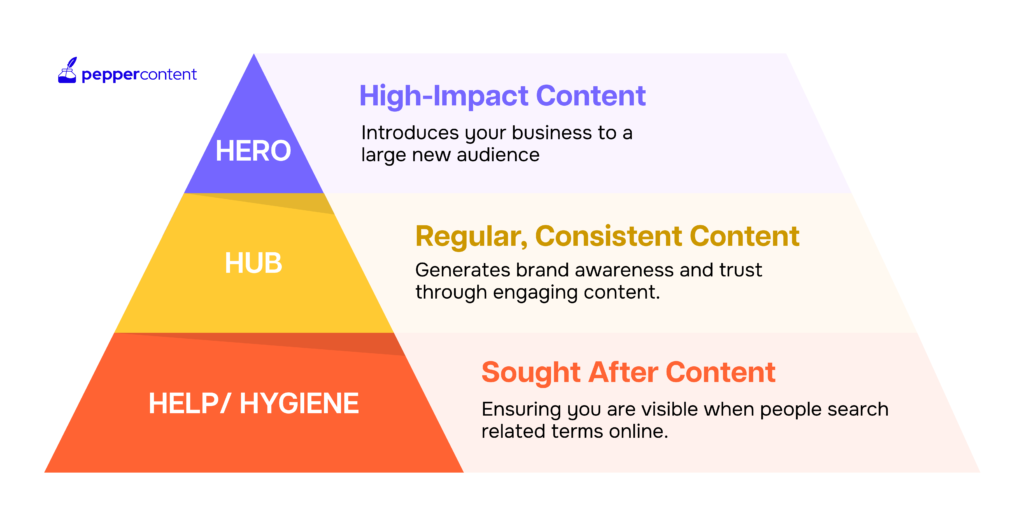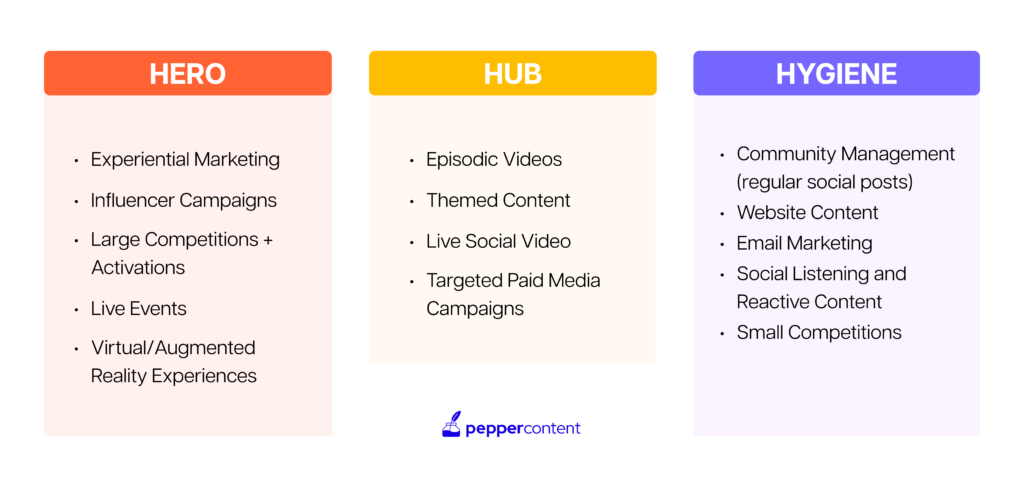How To Implement Hero, Hub, And Hygiene In Your Content Strategy?

Are you tired of creating content that fails to drive traffic and engage your audience? It’s time to adopt Youtube’s Hero, Hub & Hygiene framework and create content that resonates with your audience at every stage of their journey.
In this article, we’ll delve into the three layers of the content pyramid – Hero, Hub, and Hygiene – and discuss how to balance them. We’ll also show you how to analyze your audience to create effective content for each layer and incorporate video content into your strategy. Let’s explore real-life examples of successful content strategies that have implemented this framework.

What is the Hero, Hub, and Hygiene Model?
The Hero, Hub, and Hygiene model is a content creation framework developed by YouTube that helps businesses plan their content strategy. The model emphasizes creating content in three distinct categories: Hero, Hub, and Hygiene.
Hero Content
Hero content is designed to attract new audiences and create brand awareness. It is typically a one-time event or piece of content that generates buzz through social media shares or viral marketing. An example of this is Nike’s “Breaking2” campaign where they attempted to break the two-hour marathon barrier.
Hub Content
Hub content is aimed at engaging your existing audience by creating regular, episodic content that encourages them to subscribe to your channel or visit your website regularly. This content can range from a series of webinars on a particular topic to a podcast series. An excellent example of this is the TED Talks series on YouTube.
Hygiene Content
Hygiene content focuses on providing solutions to your audience’s everyday questions. It includes evergreen content like tutorials, how-to guides, and FAQs. An example of this is Buzzfeed Tasty’s recipe videos on Facebook.
It’s important to have a balance between these three types of content for a successful marketing campaign. While hero content can generate buzz and attract new audiences, hub, and hygiene content ensure loyalty and engagement from your existing customers.
Analyzing Your Audience Needs for Each Layer
Understanding your audience is key to creating effective content for each layer of the Hero, Hub, and Hygiene model. By analyzing your audience’s needs and preferences, you can create content that speaks directly to them and helps achieve your marketing goals.
Start by using tools like Google Search Console (GSC) to understand user search behavior. This will provide insights into what topics your audience is searching for and what keywords they are using to find them. Use this information to create Hub content that addresses their specific needs.
Pepper’s platform recommends the right clusters, themes, and keywords by looking at competitor data and filtering KWs you’re already ranking for. Click here to know more about Pepper CMP.
You can also conduct surveys or polls on social media platforms to understand what type of content resonates with your audience. This information can help you create more targeted Hero content that captures their attention and builds brand awareness.
For Hygiene content, analyze customer feedback and reviews to identify pain points or common problems they face. Create how-to videos or blog posts that offer solutions and address these pain points directly. This will help build trust with your audience and establish you as an authority in your industry.

By understanding your audience’s needs for each layer of the content pyramid, you can create effective content that drives engagement and achieves your marketing goals. Remember, the key to success is finding a balance between Hero, Hub, and Hygiene content that speaks directly to your audience at every stage of their journey.
Incorporating Video Content into Your Strategy
Video content has become an increasingly important component of any successful marketing strategy. Incorporating video into each layer of the Hero, Hub, and Hygiene model can help engage your audience and boost your brand’s visibility.
Hero content offers a unique opportunity to create viral videos that can spread rapidly on social media platforms. These videos are usually short, attention-grabbing, and entertaining, to create brand awareness. A great example of hero content is the Dollar Shave Club’s “Our Blades Are F***ing Great” video that went viral and helped the brand to gain millions of views within the first few months of its release.
Hub content aims to maintain your audience’s interest by offering them valuable information regularly. Video is a great tool for creating hub content in the form of tutorials or behind-the-scenes footage. For instance, the “Will It Blend?” series from Blendtec, where they test various household objects in their blenders, has helped them attract an engaged audience and establish themselves as a leader in their industry.
Hygiene content helps your audience address specific problems or questions they may have. Videos can be used to create helpful how-to guides or explainer videos that answer common questions related to your product or service.
So, as you can see, incorporating video content into each layer of the Hero, Hub, and Hygiene model is crucial for modern-day marketers. The video has proven to be an effective tool for creating engaging content that resonates with audiences across all stages of their buying journey. By leveraging this powerful medium, you can drive more traffic, build brand awareness, and ultimately grow your business.
Real-life Examples of Effective Content Strategies
To understand how the Hero, Hub, and Hygiene content model works in practice, let’s take a look at some successful examples from top brands.
One practical example of Hero content can be seen in Red Bull’s Youtube channel. Their high-energy extreme sports videos showcase their brand and capture viewers’ attention. This type of content is meant to generate awareness and attract new followers to the channel.
For Hygiene content, Sephora’s Makeup Tutorials provide a great example. Their videos offer step-by-step instructions on how to use their products, providing value to their customers while also promoting their brand. This type of content is aimed at providing information that customers are already searching for.
Finally, for Hub content, consider Buzzfeed’s Tasty channel. Their short recipe videos are both informative and entertaining, perfectly suited for social media sharing. This type of content is focused on engagement, encouraging viewers to interact with the brand and share the content with their friends.
By examining these examples, we can see how brands have successfully adopted the Hero, Hub, and Hygiene framework to create compelling content that attracts new followers while also engaging existing ones.
We hope you’re inspired to start implementing this framework into your marketing strategies immediately with these real-life examples.
With the Hero, Hub, and Hygiene framework, you can create compelling content for every stage of your campaign. Remember to analyze your audience, and incorporate video content.
And if you are looking to generate creative and efficient ideas for Hero, Hub, and Hygiene framework, try out Pepper.ai with the utmost ease.
FAQs
1. What is the difference between Hero, Hub, and Hygiene content?
Hero content is attention-grabbing, often viral, and meant to build brand awareness. Hub content is recurring and meant to engage your audience regularly. Hygiene content is practical and informative, meant to solve your audience’s problems.
2. How do I determine which layer of content to create?
Analyze your audience’s needs and behavior for each layer of the pyramid. Look at what they search for online or what topics they engage with consistently.
3. Can I use video for all three layers of content?
Yes! Video can be used for hero, hub, and hygiene content. It’s a versatile medium that can engage audiences in many ways.
4. Is there a specific ratio I should follow when creating these types of content?
There is no set ratio. However, in general, you should aim for a balance between all three types of content.
5. What are some examples of brands successfully using this strategy?
Red Bull’s Youtube channel has effective hero content while Sephora’s Makeup Tutorials are great examples of hygiene content. Many brands effectively use hub content through regular blog posts or social media updates.
Latest Blogs
Learn how to rank on AI search engines like ChatGPT, Perplexity, and Gemini by optimizing your content for authority, structure, and relevance. Stay ahead in AI-driven search with this strategic guide.
Explore the best healthcare SEO services for your medical practice. Improve online visibility and effectively reach more patients in need of your services.
Discover top social media agencies specializing in banking solutions, enhancing financial services and driving engagement.
Get your hands on the latest news!
Similar Posts

Content Strategy
5 mins read
Choosing The Best Healthcare Marketing Agency For Effective Content Solutions

Content Marketing
4 mins read
Top 10 Agencies B2B SaaS Content Marketing for B2B Success

B2C Marketing
5 mins read